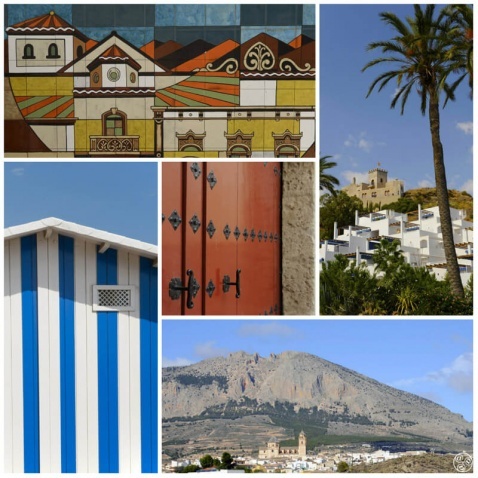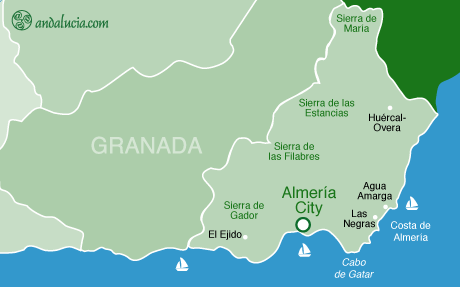
Almeria villages clockwise: Viator, Mojacar, Velez-Rubio, Mojacar, Albox |
|
Highlights of Villages & Small Towns of Almeria province
Villages of cave-dwellers
Like neighbouring Granada, Almeria province is famous for its troglodytic villages, where many homes are dug out of soft sand-coloured cliffs. These "casas-cuevas" (cave-houses) provide excellent insulation from the dry, desert-like fierce heat typical of this province. They often have a conventional façade with windows and tiled roofs, while above are chimneys that jut up from the earth behind. Chimney-like skylights are dug for interior lighting of the cave.
As well as the casas cuevas in the Barrio de Chanca area in Almeria city, the most interesting cave-dweller settlements are Alhabia, Gádor and Benahadux, in the region around Santa Fé de Mondújar and near the recently excavated site of Los Millares, the largest Bronze Age settlement in Europe with a prehistoric fortress built 2,000 years before Christ. There are also caves in the Almeria section of the Alpujarras, at Fondón and at Láujar de Andarax.
Coastal villages
Mojácar is the largest resort on the Costa Almeria, popular with foreign residents, many of them British; around half of its population of 5,000 come from the EU. Mojácar is divided between a stunning hilltop old part of the town, Mojácar Pueblo, and the newer seafront Mojácar Playa, built alongside a superb sandy beach. A more low-key resort is San José, the centre of the extraordinary Cabo de Gata-Níjar Natural Park, with some of Andalucia´s most magnificent beaches such as the Playa de los Genoveses and the Playa de Monsul. If San José is too developed try Isleta del Moro the smallest of them all, or Agua Amarga under Mesa Roldan a flat-topped extinct volcano, part of a massive rocky headland topped with a lighthouse and old fort.
North of Mojácar is the small resort of Villaricos with a pebble beach. Cuevas del Almanzora , a small town and Pulpí now famous for the Geode you can visit down the mine.
Roquetas de Mar is a popular resort 25km west of Almeria with a broad, sandy beach and many watersport activities and golf courses. Almerimar to the west is a relaxins seaside golf resort.
Find a full list and page about each of Almeria's coastal villages here.
Northern Mountains
The villages in the far north of the province have a flavour all of their own, since they were some of the first in the region to be reconquered by the Christians. The austere Castilian influence can be seen in the stone castles and palaces of Vélez Rubio and Vélez Blanco, whose elegant Renaissance courtyard now stands in the Metropolitan Museum of New York. Vélez Blanco is also the gateway to the Sierra María-Los Vélez Natural Park, a mountainous area with extensive forests, which are a rare sight in this otherwise arid, barren province.
Dissecting the area south of the Sierra de María east-west is the Almanzora river and in its valley are Serón and Tijola, with their famous fountains, and Purchena. South of Purchena is Macael, a well-known centre of marble quarries.
Spaghetti Westerns & solar energy in the Spanish desert
In the 1960s Italian movie directors like Sergio Leone filmed their own version of the North American Wild West among the mesetas and cactus trees of the Desierto de Tabernas Natural Area and the ramshackle film sets have been turned into a tourist attraction, Mini Hollywood, complete with trading posts and double-door saloons. The nearby village of Tabernas makes a good base for exploring the desert and has a charming church built in the Mudejar style.
On the edge of the arid Sierra de Gádor is the spa town of Alhama de Almería, renowned for its thermal waters with a modern hotel on the site of the original baths.
Láujar de Andarax is the largest village in the Sierra Nevada National Park in Almeria province. Above Láujar are some superb views across the valley below and there are many good walks in the surrounding hills. Just outside the town is a great picnic spot on the shady banks of the Andarax river, close to its source.
Pottery & Ceramics
The village of Níjar is famous for its numerous pottery workshops as well as its production of jarapas, which are rugs and bedcovers made from rags. The barren, dusty hills around the village are sprinkled with picturesque villages some of which also have a tradition of producing ceramics, such as Sorbas, Ulelia del Campo, Lubrín, Bédar and Vera, as well as the town of Albox, north of Ulelia del Campo.
